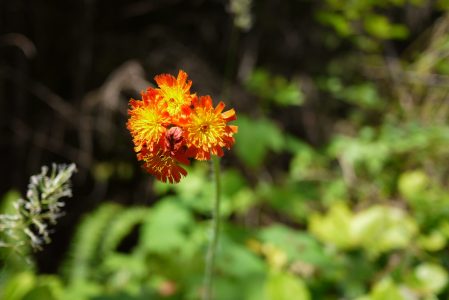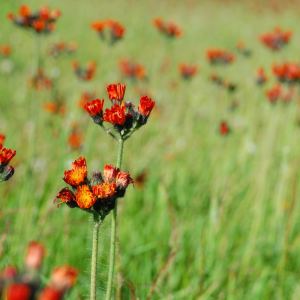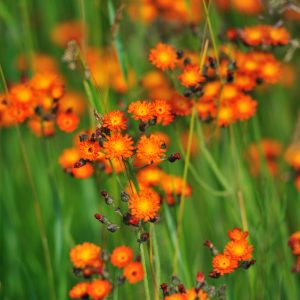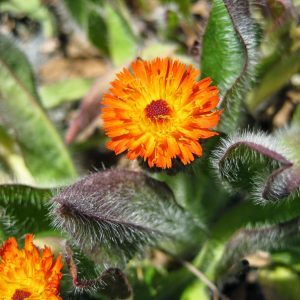My orange flowers may seem pretty at first,
But my rapid spread is really a curse.
In clearings, meadows, roads, and pastures,
I decrease biodiversity, what a disaster!

I Spy in the Sea to Sky…
This plant has a cluster of vibrant orange flowers, and was likely brought over from Europe as a garden ornamental or as part of contaminated pasture seed. Can you guess what it is?
It’s Orange Hawkweed (Hieracium aurantiacum L.)! It flowers from May to August, and likes well-drained, coarse-texture soils. Watch out for it near natural open areas and disturbed sites, such as roadsides or even along the valley trail. Orange Hawkweed is a moderate-priority plant in the Sea to Sky. We aim to control it at some strategic locations in the region, as per SSISC’s priority plant species list.

Orange Hawkweed can be easily identified by several distinctive features:
- Bright orange flowers growing in clusters
- Slender, hairy, unbranched stems that contain a milky sap
- Hairy leaves arranged in a rosette at the base of the plant
- Height of up to 60cm tall


Does Orange Hawkweed have any look-alikes?
While there are several native and invasive hawkweed species in the Sea to Sky, orange hawkweed is the only one with orange flowers. If you see an orange-flowered hawkweed plant, you can be quite sure that you’re looking at the invasive orange hawkweed!
However, there are other species that can be confused with Orange Hawkweed:
- Orange Agosteris (Agoseris aurantiaca) is native to BC. It has one flower at the end of its stem, while Orange Hawkweed has a cluster of flowers.
- Scarlet Paintbrush (Castilleja miniata) is a wildflower that is also native to BC, with orange to red paintbrush-shaped flowers.
- Before flowering, the rosettes of Orange Hawkweed look very similar to other Yellow Hawkweed species. It is much easier to identify Orange Hawkweed after flowering.
Why is Orange Hawkweed such a concern in the Sea to Sky?
Orange Hawkweed is an aggressive spreader with no natural predators in our area. It spreads by seed and vegetatively by its stolons (above-ground runners) and rhizomes (underground roots).
It forms dense mats that outcompete native species, leading to a drastic change in vegetation, loss of forage for livestock, and a reduction in biodiversity. It often forms monocultures and reduces the presence of other wildflowers.
If you want to know what you can do to help, read more about Orange Hawkweed on its species profile page.
I Spy in the Sea to Sky Contest
Guess the invasive species in our I Spy in the Sea to Sky weekly social media post, June through August, to enter our giveaway.
At the end of each month, one lucky commenter will win a native wildflower seed mix packet! Follow us and comment on social media to participate!
CONTEST RULES:
- Comment your guess (common or species name) on the social media post (on Instagram or Facebook) to enter. Only correct guesses will qualify you for the giveaway.
- One entry per person per post.
- Anyone can play, but only Sea to Sky region residents can win.
- Entries will close at 11:59 PM PST on June 30th, 2024.
- Winners will be announced in the first week of July in an Instagram story AND contacted directly via their platform of entry.






Add Comment